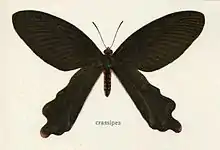| Black windmill | |
|---|---|
 | |
| Scientific classification | |
| Domain: | Eukaryota |
| Kingdom: | Animalia |
| Phylum: | Arthropoda |
| Class: | Insecta |
| Order: | Lepidoptera |
| Family: | Papilionidae |
| Genus: | Byasa |
| Species: | B. crassipes |
| Binomial name | |
| Byasa crassipes | |
Byasa crassipes, the black windmill, is a butterfly found in India and Southeast Asia that belongs to the windmills genus, Byasa, comprising tailed black swallowtail butterflies with white spots and red submarginal crescents.
Range
Northeast India (Manipur), Myanmar (southern Shan states), northern Thailand, northern Laos, northern Vietnam (Tonkin), and possibly southern China.[2]
Status
The black windmill is very rare and is protected by law in India. More information is required on this species.
Description
The wingspan is 110–120 mm. It is a black butterfly which is unmarked except for obscure red spots on the upper hindwing. The tail is red tipped below.
Male upperside: Forewing dark fuliginous (sooty) black, with black veins, a longitudinal streak between the veins and streaks within the cell. Hindwing very narrow anteriorly and much prolonged posteriorly, exterior margin broadly scalloped, tail very broad and short; abdominal margin with a very long folded lappet, which when opened displays a lengthened greyish-white woolly androconial patch; colour dull greyish black, with two upper marginal and two sub-anal lunules, tip of the tail very obscure dusky red. Underside: forewing paler. Hindwing dull black, with the two upper and lower marginal lunules, an irregular-shaped anal lunule, and the tail tip bright crimson. Thorax and abdomen above black; front of head and thorax and abdomen beneath crimson; abdomen beneath with black segmental bands; hind tibiae very thick; antennae and legs black.[3]
Taxonomy
No separate subspecies have been described.
Habits
Recorded from Manipur between 1,000 and 2,500 ft (300 and 760 m).
See also
References
- ↑ Häuser, Christoph L.; de Jong, Rienk; Lamas, Gerardo; Robbins, Robert K.; Smith, Campbell; Vane-Wright, Richard I. (28 July 2005). "Papilionidae – revised GloBIS/GART species checklist (2nd draft)". Entomological Data Information System. Staatliches Museum für Naturkunde Stuttgart, Germany. Archived from the original on 9 September 2010. Retrieved 21 June 2013.
- ↑ Philip Lo (Kadoorie Farm and Botanic Garden, Hong Kong); International), Eresha Fernando (BirdLife; Moonen, Jan; Kehimkar, Isaac; Jangid, Ashish (2019-02-28). "IUCN Red List of Threatened Species: Byasa crassipes". IUCN Red List of Threatened Species. doi:10.2305/iucn.uk.2020-3.rlts.t121971897a176105416.en. Retrieved 2021-05-20.
- ↑ Bingham, C.T. (1907). The Fauna of British India, Including Ceylon and Burma. Vol. II (1st ed.). London: Taylor and Francis, Ltd.
- Collins, N. Mark; Morris, Michael G. (1985). Threatened Swallowtail Butterflies of the World: The IUCN Red Data Book. Gland & Cambridge: IUCN. ISBN 978-2-88032-603-6 – via Biodiversity Heritage Library.
- Evans, W.H. (1932). The Identification of Indian Butterflies (2nd ed.). Mumbai, India: Bombay Natural History Society.
- Haribal, Meena (1992). The Butterflies of Sikkim Himalaya and Their Natural History. Gangtok, Sikkim, India: Sikkim Nature Conservation Foundation.
- Wynter-Blyth, Mark Alexander (1957). Butterflies of the Indian Region. Bombay, India: Bombay Natural History Society. ISBN 978-8170192329.
External links
- Global Butterfly Information System Syntype text, images